
OVERVIEW
MANAGEMENT
PERFORMANCE
POSSIBILITIES
CAPITALS
ACTIVITIES
ACTORS
BURGESS
|
GUN VIOLENCE
WASHINGTON POST SERIES (MARCH 2023) Decades of marketing reinvented the AR-15 into a top-selling firearm Flannel, muddy girl camo and man cards. See the ads used to sell the AR-15.
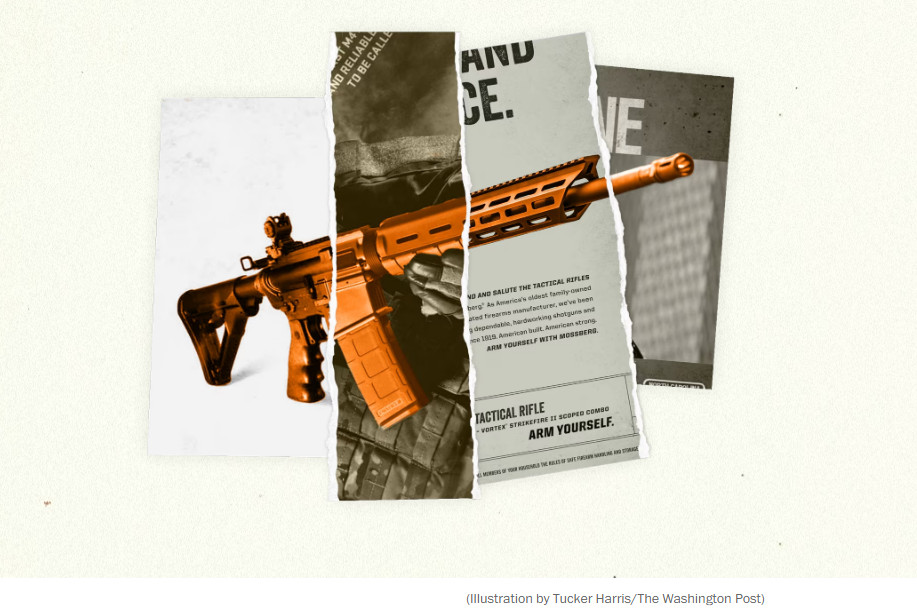
Illustration by Tucker Harris/The Washington Post Original article: https://www.washingtonpost.com/business/interactive/2023/history-of-ar-15-marketing/ Peter Burgess COMMENTARY The United States has enormous potential, but there are many different issues that get in the way. Guns and gun violence is one of these. The idea that guns are killing young people in the United States more than anything else is a ridiculous state of affairs, and the fact that the politicians have been unable to pass legislation to limit access to guns is just plain idiotic. Peter Burgess | ||||||||||||
|
Decades of marketing reinvented the AR-15 into a top-selling firearm
By Alex Horton, Monique Woo and Tucker Harris Updated April 11 at 7:59 p.m. ... Originally published March 27, 2023 The Colt AR-15 looked more like a laser blaster than dad’s trusty rifle when it hit the market in 1964. It was made from aluminum and plastic, not the heavier metals and wood used in traditional firearms. Its cartridges were tiny compared with typical hunting ammunition. And it was all black — a dour monochrome far from the rich walnut accentuating many guns at the time. In short, the AR-15 presented a litany of challenges for those tasked with trying to sell it. Many gun enthusiasts and industry executives were initially skeptical that an offshoot of a weapon originally designed for combat could sell in a marketplace focused on extolling the virtues of rifles for hunting and handguns for self-defense. But in the ensuing decades, the AR-15 would become a powerful symbol for whoever invoked it, from gun-control advocates decrying it as a preferred tool for mass killers to gun owners who championed it as the pinnacle of Second Amendment rights. 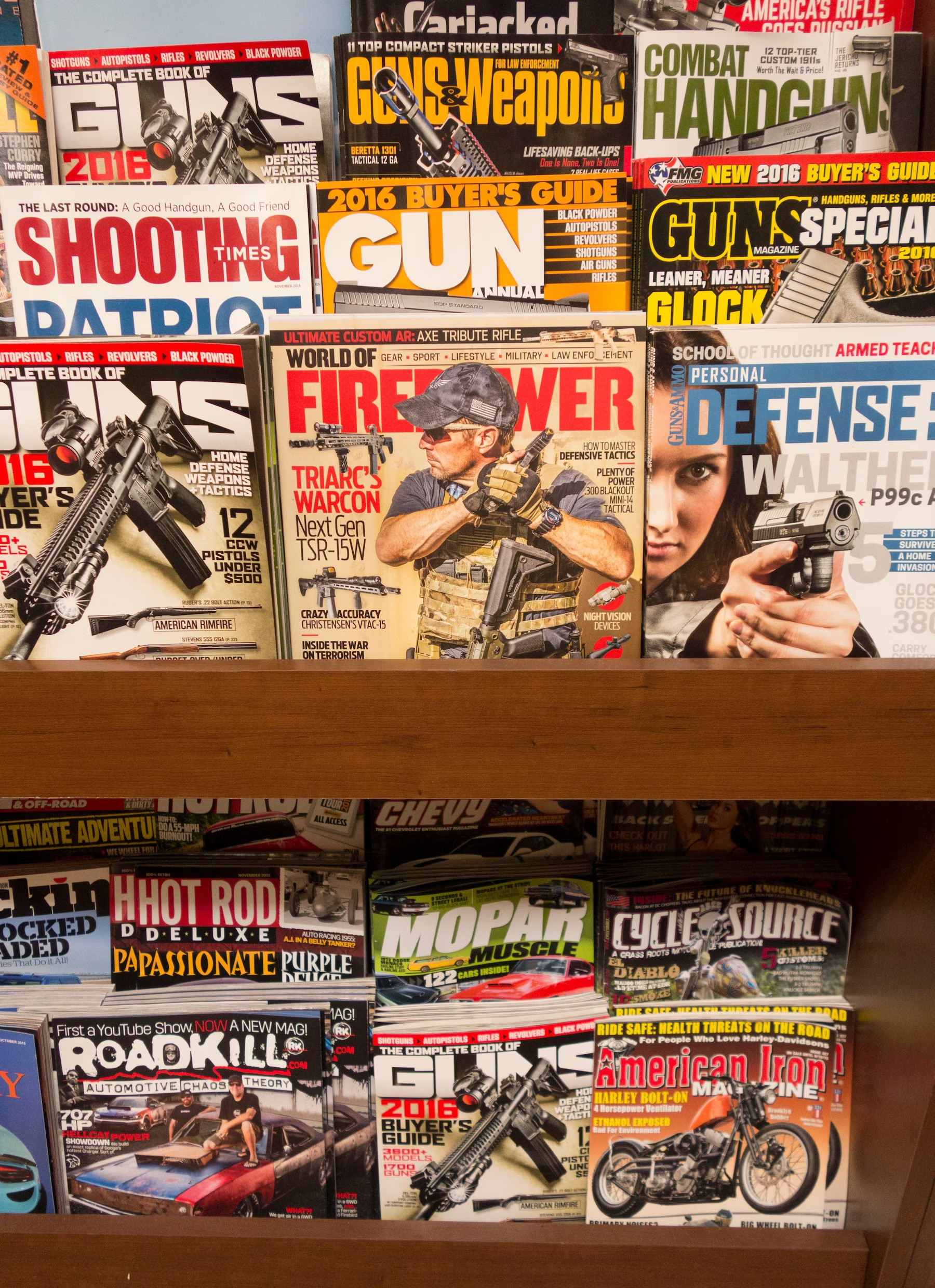
AR-15 magazine collage Through it all, the gun also became a point of emphasis for gun companies that turned to tactical weapons as an emerging and lucrative market. An examination of the ads used to sell the AR-15, from the 1960s until today, reveals how the gun industry followed social and cultural changes as it sought to broaden the appeal of an unusually polarizing consumer product. This analysis is based on a review of more than 400 advertisements, catalogue entries, brochures, social media posts and other messages produced by gun manufacturers and ad agencies. Many of the ads appeared in gun-oriented publications, including American Rifleman and Guns & Ammo — and some have been cited over the years in lawsuits and Federal Trade Commission complaints filed by victims of gun crimes or their families. The Washington Post sought additional analysis from experts on the intersection of marketing and culture. The ads show how an industry attuned to public opinion across the decades, particularly among its heavily conservative customer base, has heralded the AR-15 as a weekend toy, an effective tool for hunting and home defense, and an expression of masculine energy — at times, all at once. Frequent images of police and soldiers wielding tactical rifles in the field urged civilian buyers to, as one ad put it, “use what they use.” Unless otherwise noted, gunmakers whose ads appear in this story did not respond to requests for comment. 1957 Armalite makes a prototype Gunmaker Armalite starts work on a prototype based on the U.S. military’s desire for a lightweight rifle capable of automatic fire. The company dubs it the Armalite Rifle Model 15, or AR-15. 1959 Colt acquires the AR-15 Unconvinced its gun had a military future, Armalite sells the rights for the AR-15 to Colt’s Patent Firearms Manufacturing Co. Colt would later produce the rifle for the U.S. military, which designates it the M16. 1964 AR-15 enters the civilian market Colt releases the AR-15 Sporter, a semiautomatic variant of its military rifle, for civilian buyers. A modest debut The industry’s initial advertising messages often sought to portray the AR-15 as an enhancement for hunters and others who used their guns for recreation. The earliest ad reviewed by The Post was a 1964 clipping from Guns magazine in which Colt pitched its AR-15 Sporter. The ad suggested “this is part of what you already do,” said Grant Reeher, a political science professor and director of the Campbell Public Affairs Institute at Syracuse University, who is at work on a book about gun politics and culture. “… you’re ready for a new hunting adventure.” “… weighs only six pounds.” “If you’re a hunter, camper, or collector …” 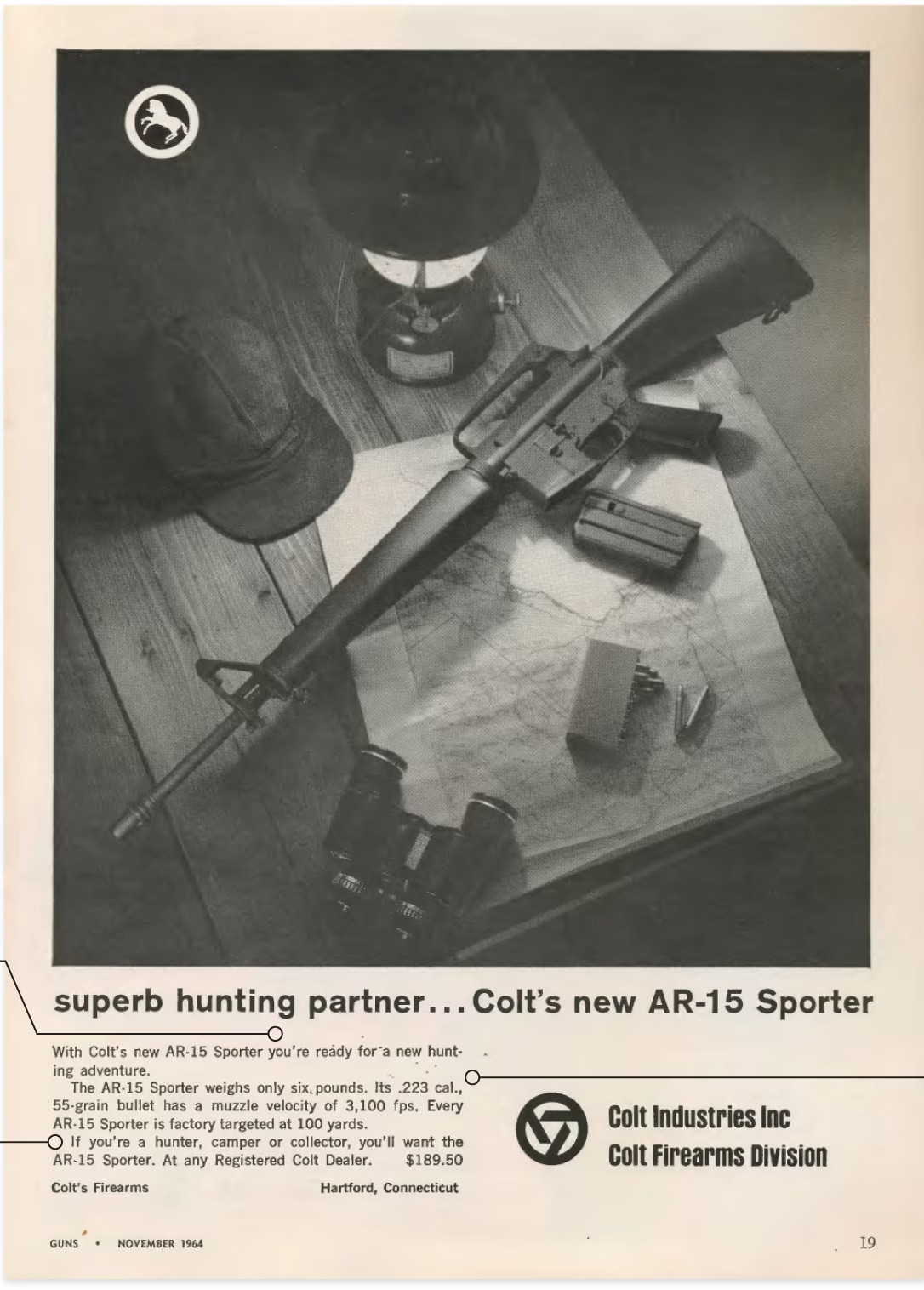
The focus on hunting was premature, Reeher said. Early rifles were inaccurate for varmint hunting, and the newly developed .223 cartridge was too slight for bigger game. The rifle did not yet have an identity. One had to be crafted. Colt was “fumbling around, looking for the angle to take,” Reeher said. Yet soon after launch, Colt would get a boost of legitimacy from the Vietnam War. The company’s AR-15 was the civilian variant of the M16 rifle, which the U.S. military adopted as its service rifle, and the conflict helped popularize both weapons. “Now you can buy a hot new combat rifle for sport,” Popular Science wrote in early 1965, welcoming the new AR-15. Despite reliability problems of the M16 voiced by soldiers in the late 1960s that triggered congressional inquiries, Colt and other companies continued to highlight the AR-15’s military progeny as a growing part of the weapon’s cultural identity. “The Sporter looks like, feels like, and performs like its military cousin,” Colt said in a 1977 brochure. Press Enter to skip to end of carousel Common themes in early advertising of the AR-15 included hunting, “varmint control” and highlighting the weapon’s military pedigree. Hover on (or tap and hold) image to zoom Colt illustration featuring a man loosely holding an AR-15 standing at his side in a rural area. He is looking out over a field surrounded by a barbed wire fence. There is a barn across the field and a mountain range in the distance. 1985, Colt (American Rifleman magazine ) Colt ad with an image of the AR-15 over a photo of a forest with a buck in the center. 1993, Colt (“1993 New Products Tri-fold” brochure) Note: This rifle is built on the AR platform but is chambered in a caliber larger than typical AR-15s. 1977, Colt (Colt catalogue) “… looks like, feels like, and performs like its military cousin.” “… used efficiently for both varmint control and hunting.” 1985, Colt (American Rifleman magazine ) “For a rancher …” “… battle proven …” “… as accurate as it is dependable.” 1993, Colt (“1993 New Products Tri-fold” brochure) Note: This rifle is built on the AR platform but is chambered in a caliber larger than typical AR-15s. “… game-getting power …” “… shrugs off the abuses of brush and boulders …” “… hunting companion.” End of carousel 1968 Gun Control Act of 1968 Prompted by the assassinations of President John F. Kennedy in 1963 and Martin Luther King Jr. in 1968, this act mandates that only a licensed dealer can sell a rifle or shotgun to someone at least 18 and a handgun to someone at least 21. The act also required serial numbers for firearms. 1977 Expiration of Colt’s patents An active marketplace emerges for other manufacturers to produce and sell their own semiautomatic rifles built on the AR-15 platform. The term “AR-15” is derived from Armalite’s original design rather than a specific brand and has been used since as a catchall to describe the rifle style. Promoted as protector As public concerns about crime mounted in the 1980s and 1990s, manufacturers drifted from a focus on hunting and outdoor imagery to emphasizing self-defense and law enforcement themes. The shift coincided with moves by numerous states to expand the rights of residents to carry concealed weapons, helping transform gun culture into one centered on personal protection, studies have shown. AR-15 marketers started to adjust their depiction of what was on the receiving end of the barrel. “People, rather than animals, were the target,” Reeher said. “That allows it to be sold more as a self-defense weapon, particularly inside the home.” “… family of weapons used by law enforcement and military forces …” “… eliminates hours of training and familiarization …” 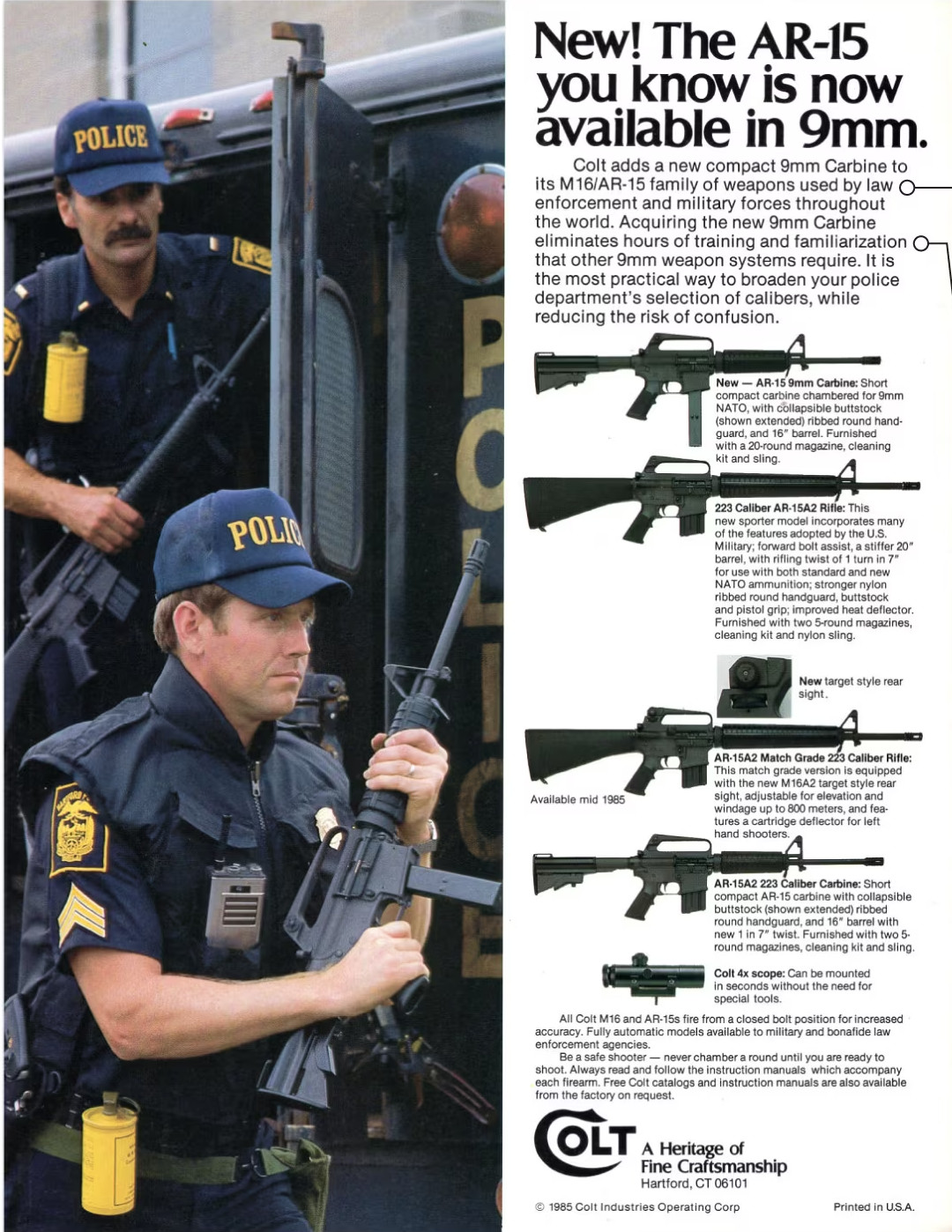
A single page from a spread in a 1977 Colt Catalog. It is a close-up of the butt of an AR-15 against a white background. 1977, Colt (Colt catalogue) 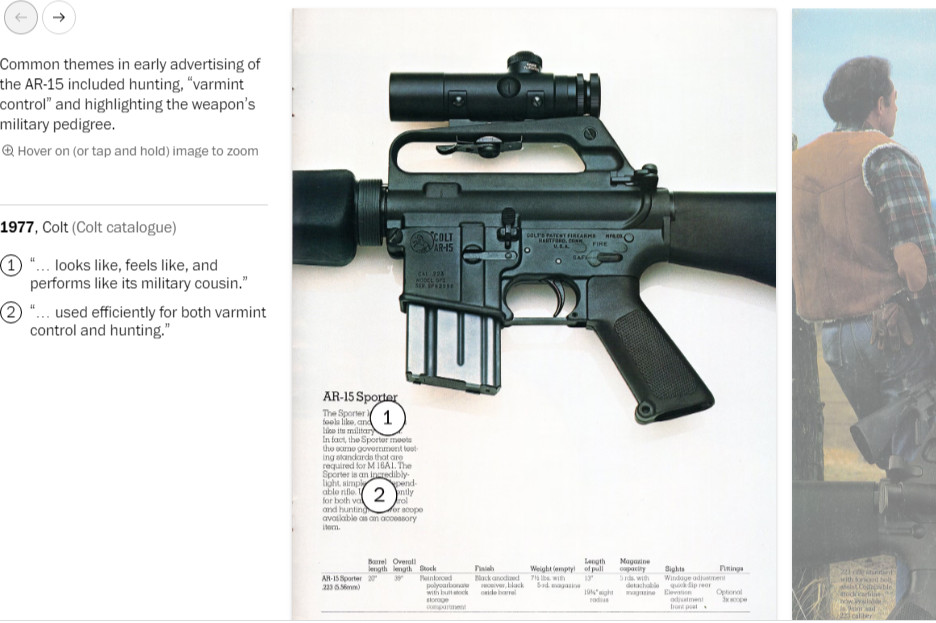
4 1985, Colt (Colt Catalog) While police officers became a fixture in AR-15 ads, gunmakers also chose images that suggested professional-grade weapons were necessary for civilians seeking protection from violent crime. One print ad for Stag Arms rifles spoke to police and prospective buyers. “When you go Stag, you’re not alone,” it read, showing what appears to be a nighttime crime scene. According to experts, police imagery has the additional effect of conferring increased legitimacy. “It signals the practical benefit to the consumer and the sort of symbolic benefit,” said Aimee Huff, an associate professor at Oregon State University specializing in marketing and gun culture. Press Enter to skip to end of carousel Gunmakers increasingly focused ads on self-defense and depictions of law enforcement as crime became a bigger public issue. Hover on (or tap and hold) image to zoom Photos of 3 scenes fade into a blue background. Each scene has a related firearm sitting in the foreground and bright yellow words. From top to bottom, the words read 'To uphold', 'To protect', 'To serve'. 2008, Smith & Wesson (Guns & Ammo magazine) Smith & Wesson ad: 'Tested. Proven. Selected.' It features a close-up of the upper body of a man in tactical gear and aiming an AR-15. Beneath the man there is a line of badges from 7 police departments. 2010, Smith & Wesson (American Rifleman magazine) Stag Arms ad: 'When you go STAG You're not alone.' The ad imagery features the silhouette of a man walking at night on the road toward a group of vehicles with blue and red lights. 2008, Stag Arms (Guns & Weapons for Law Enforcement magazine) 2008, Smith & Wesson (Guns & Ammo magazine) “military & police” 2010, Smith & Wesson (American Rifleman magazine) “Tested. Proven. Selected.” “… proving itself by winning department testing and evaluations across the country.” “… tactical advantage …” 2008, Stag Arms (Guns & Weapons for Law Enforcement magazine) “When your life depends on it …” “… you’re never alone.” End of carousel 1989 Executive order bans imports of some rifles President George H.W. Bush signs an executive order banning the importation of semiautomatic rifles after a gunman used a Chinese-made AK-47 variant to kill five students outside a school in Stockton, Calif. 1994 Federal assault weapons ban President Bill Clinton pushes the assault weapons ban through Congress with some bipartisan support. The Public Safety and Recreational Firearms Use Protection Act outlawed firearms with common semiautomatic rifle features, such as adjustable stocks and detachable magazines. People who already owned such guns were allowed to keep them. 2001 Sept. 11 attacks prompt U.S. wars Imagery from the wars in Afghanistan and Iraq shows troops carrying M4 rifles, the military cousin of the modern AR-15. 2004 Ban expires The assault weapons ban sunsets, allowing civilians to once again purchase such rifles, including versions of the AR-15, depending on local laws and restrictions. In the shadow of war The sunset of the assault weapons ban in 2004 allowed another way to channel military valorization unleashed by the U.S. wars in Iraq and Afghanistan, prompting gunmakers and accessory companies to add tactical appeal to their wares, Huff said. Austere combat environments became common backdrops in ads for AR-15s and accessories, and rifles once sold almost exclusively in black became available in desert tan and foliage green. The bearded commando decked out in tactical gear emerged as a potent pop culture image, playing a central role in video games like the Call of Duty series and box office smashes like “Lone Survivor.” 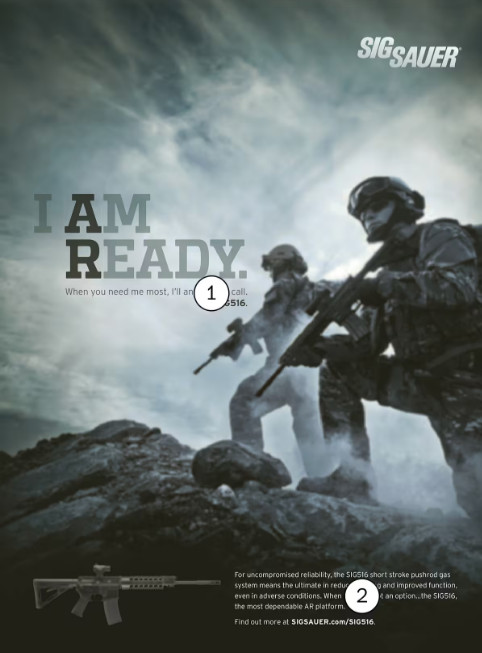
8 ... In the wake of the Sept. 11 attacks, gunmakers marketed the gun with nationalistic vocabulary and military lexicon. The words 'I am ready' line up so that the letters 'AR' are particularly bold. In front of a gray-blue sky, two men in military uniforms on rocky terrain carry AR-15s. 2011, Sig Sauer (American Rifleman magazine) Note: This rifle has many of the AR-15's design characteristics but uses a piston operating system, rather than a typical gas impingement. Sig Sauer ad with a soldier in camouflage featured prominently in the foreground, holding an AR-15. He has his finger on the trigger. In the background, there is a helicopter flying over rocky terrain. 2012, Sig Sauer (American Rifleman magazine) A bright yellow background with a large AR-15 in the center. Big, bold words above the firearm say 'Engineered to the specs of freedom and independence.' 2017, Mossberg (American Rifleman magazine) 2011, Sig Sauer (American Rifleman magazine) Note: This rifle has many of the AR-15's design characteristics but uses a piston operating system, rather than a typical gas impingement. “… I’ll answer the call.” “When failure is not an option …” 2012, Sig Sauer (American Rifleman magazine) “… accurate and reliable …” “When it counts” 2017, Mossberg (American Rifleman magazine) “Stand and salute the tactical rifles” “… family-owned …” “American built. American strong.” End of carousel “It’s no accident that when you get to the 2000s, you’re seeing people in uniform over and over again,” Reeher said. The Special Operations raid to kill Osama bin Laden in 2011 was a key moment in the development, and after that, “everybody wanted to be a Navy SEAL.” Gunmakers seized on the fantasy. In 2012, Daniel Defense produced an ad featuring a short-barreled rifle using a rail system for attaching accessories that the company says is designed for Special Operations Command. “… military adopted …” “Whether you are patrolling a foreign land, the city streets, or your own home …” “Always made in the USA” The advertisement then links the AR-15 with the country’s overseas wars, showing how a weapon first described as a hunter’s tool was now being presented as the everything rifle. “Whether you are patrolling a foreign land, the city streets, or your own home,” the ad said, “your rifle can’t let you down.” 2012 Mass shooting in Newtown, Conn. Armed with two handguns, one shotgun and a Bushmaster XM15-E2S rifle, a gunman kills his mother in their home and then 26 people at Sandy Hook Elementary School before he fatally shoots himself. AR-15 production doubles after Sandy Hook According to industry data, production soars, suggesting consumers feared a new ban would be passed. 2014 “American Sniper” is released This film about a Navy SEAL become the highest-grossing war film ever released in the United States. 2016 “America’s Rifle” The National Rifle Association dubs the AR-15 “America’s Rifle,” part of an effort to bolster the image of a weapon coming under attack from gun-control advocates. Production surges leading up to the 2016 election. Production of rifles spikes by 53 percent, according to industry data, as gun rights advocates and industry allies stoke fear of new gun-control laws if Hillary Clinton succeeded in securing the presidency. 2020 Instability fuels sales AR-15 production spikes by 51 percent, prompted by the uncertainty surrounding the coronavirus pandemic, racial justice protests and a bitter presidential campaign. 
A single page from a spread in a 1977 Colt Catalog. It is a close-up of the butt of an AR-15 against a white background. 1977, Colt (Colt catalogue) A second chance The 2004 expiration of the federal assault weapons ban, which for 10 years had prohibited the sale of many AR-15s, gave the gun industry a chance for a reinvention. Some manufacturers, seeking to reintroduce the AR-15, latched on to tactical imagery and phrasing, inventing jargon along the way. “The introduction of distinctive colors and patterns, decorative handguards, and models like Panther Arms’ ‘Sportical,’ which incorporated multiple features that appeal to sport shooters buying their first AR, are all examples of efforts to differentiate from the competition,” said Michelle Barnhart, an associate professor who researches gun culture and marketing at Oregon State University. Other companies boasted about their ability to shape their products, such as the now-defunct Sabre Defence, which said in a 2008 print ad that “we don’t simply assemble our rifles, we also craft key pieces that go into them.” “It’s one of the ways Sabre Defence stood out from its competition,” said Sarah Mota, the director of operations at New Empire Industries, the company that acquired Sabre’s holdings. 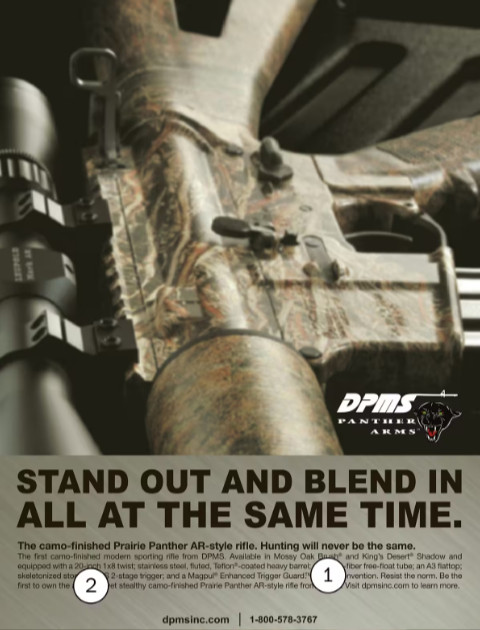
7 After the expiration of the federal assault weapons ban, gunmakers tried to capture new customers by showcasing the AR-15’s multiple potential uses while also marketing at times to women. DPMS Panther Arms ad has a close-up of an AR-15 with camo pattern. The ads states: 'Stand out and blend in all at the same time.' 2011, DPMS Panther Arms (American Rifleman magazine) Below the text 'The Sportical', there is a picture of an AR-15 in front of a red and black gradient background. Four square images stack vertically on the right of the ad, all close-ups of various AR-15 features. most of the bottom-half of the ad is taken up by a block listing all the various features. 2008, DPMS Panther Arms (Guns & Ammo magazine) Sabre ad featuring a women wearing long sleeves, sunglasses, and gloves. She's aiming an AR-15. There are trees in the background. 2008, Sabre (Guns & Ammo magazine) Colt ad features close-up of AR-15 with custom hydro-dipped pattern. Bold words above the centered firearm state 'Just when you thoughts Colt couldn't get any better'. Two smaller images of AR-15s show different patterns. One of the small firearms is pink and labeled as 'Muddy Girl Camo' 2013, Colt (American Rifleman magazine) Springfield Armory ad with woman wearing protective eyewear and a tank top. She holding Saint AR-15 with a finger on the trigger. She is against a black background, with light illuminating the top-half of her body. Text to her right: 'Defend your legacy' 2017, Springfield Armory (American Rifleman magazine) 2011, DPMS Panther Arms (American Rifleman magazine) “Resist convention. Resist the norm.” “… attractive yet stealthy camo-finished …” 2008, DPMS Panther Arms (Guns & Ammo magazine) “Sportical” “Whether you are buying your first AR rifle, or need an affordable yet accurate plinking gun …” “Built to bridge the gap between the Sporting and Tactical markets … ” 2008, Sabre (Guns & Ammo magazine) “Shoot. Admire. Repeat.” “… we also craft …” “… flawless …” 2013, Colt (American Rifleman magazine) “… custom hydro-dipped graphics and patterns.” “… unlike anything else on the market.” “Muddy girl camo” 2017, Springfield Armory (American Rifleman magazine) “Our legacy is helping you protect yours.” “Built for the free and independent …” “… the next generation …” End of carousel Gun advertising in the last decade and a half has also increased its focus on capturing the female shooter market. Often that would include a twist on traditional gender associations, like Colt’s pink hue that it coined “muddy girl camo.” The turn has been apparent in recent years at National Rifle Association conventions, Barnhart said. “The exhibition floor included an abundance of promotional imagery featuring women wielding AR-15-style rifles,” she said. 2007 “Lone Survivor” is a bestseller The Navy SEAL memoir and subsequent film introduce shadowy commandos to audiences, helping create waves of interest in tactical weapons and gear. 2009 Launch of “Call of Duty: Modern Warfare 2” The video game, what many fans consider the high-water mark for the Call of Duty series, is released. An AR-15 is the closest a civilian can get to wielding one of the most popular guns in the game, the M4 carbine rifle. Gun industry introduces the term “modern sporting rifle” As sales of AR-15s cooled after a 2008 spike, the National Shooting Sports Foundation adopts this marketing term as a way to describe modular semiautomatic rifles like AR-15s. President Barack Obama’s inauguration Soon after Obama’s election, domestic production of semiautomatic rifles surpasses the previous year by nearly 60 percent, according to industry data, representing the first major production spike since the assault weapons ban expired. 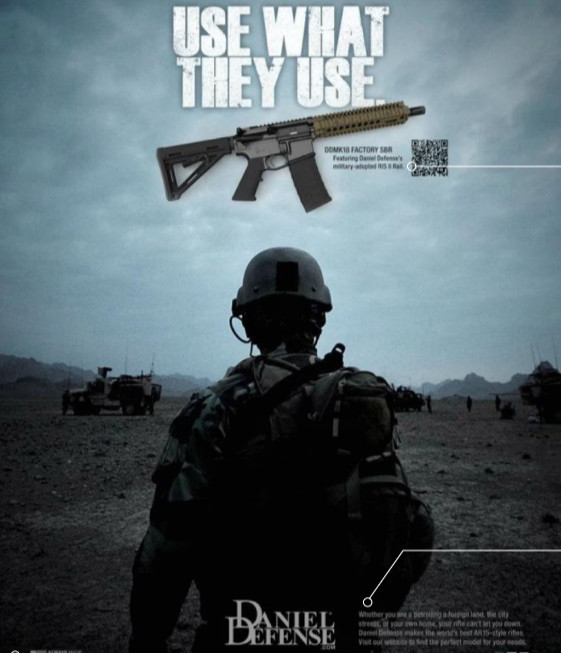
9 A message of masculinity Bushmaster presented a problem and a solution for men concerned about evolving notions of gender when it launched its ad campaign: “Consider your man card reissued.” The advertisement, which ran in magazines including the men’s publication Maxim, is notable for the placement of the rifle itself. Firearms in ads are typically shown flat with the barrel pointing in an innocuous direction, Huff said. But in this ad, the rifle is canted toward the audience and pointed left, positioning that, according to Huff, suggests conflict. “The text and the imagery clearly signal power and vaguely implicate some enemy that the gun user needs to employ their masculinity against,” Huff said. “If it’s good enough for the professional, it’s good enough for you …” 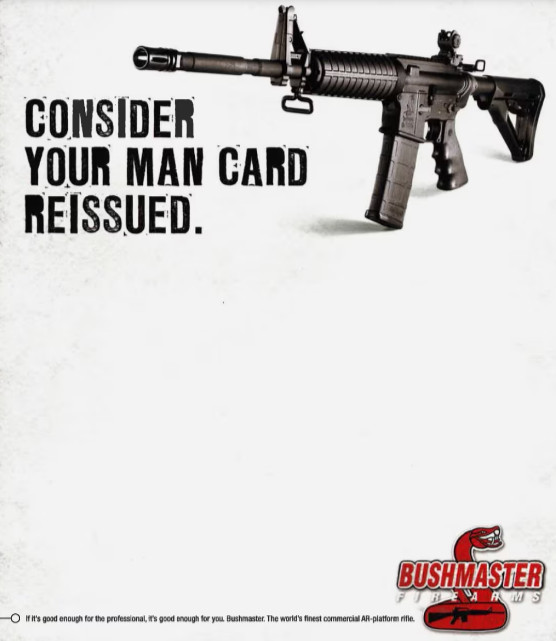
10 ... 2009, Bushmaster (Maxim magazine) The ad drew widespread scrutiny in 2012 after a gunman slaughtered 26 people at Sandy Hook Elementary School in Newtown, Conn., using a Bushmaster like the one in the image. It became a centerpiece exhibit in a lawsuit against Bushmaster owner Remington Arms filed by the families of survivors that challenged how it marketed guns. The company settled for $73 million in 2022. Other advertisements tapped into masculinity in subtle and not-so-subtle ways. Smith & Wesson declared its M&P 15-22 could help you “kick brass” and save money firing the more economical .22 cartridge. Self-defense and defending loved ones are keystone desires for many gun owners, said Barnhart, with Oregon State. That often translates to a traditional social norm of men as strong protectors shepherding family values, she said. In a social media post published by Daniel Defense in May, a child holds an AR-15-style pistol in his lap as an arm wearing what appears to be a man’s watch — presumably that of a father — gestures to him. An ammunition magazine is nearby. The caption, taken from a Bible verse, reads: “Train up a child in the way he should go, and when he is old, he will not depart from it.” 
11a ... Sen. Tammy Duckworth (D-Ill.) holds up a printout of a tweet by Daniel Defense on Capitol Hill in July. (Chip Somodevilla/Getty Images) The ad could be interpreted as “you need to teach this kid how to use this firearm so he can defend himself in the future,” Barnhart said. Daniel Defense was widely criticized for the image, which was tweeted a week before a gunman used one of the company’s rifles to carry out a massacre at a school in Uvalde, Tex., killing 21. The company took the ad down soon after. Marty Daniel, who last month stepped down as the chief executive of Daniel Defense, told lawmakers in July that the post meant to convey gun safety. “We took it down because children had just been killed and we didn’t think it was appropriate,” he said. Even some gun advocates may have felt the inclusion of a child went too far, Reheer said. “There is a lot going on with this one, for people to despise and like,” he said. About this story Reporting by Alex Horton. Additional reporting and photo editing by Monique Woo. Top illustration credits: Bushmaster ad via Maxim magazine (2009); Sig Sauer ad via American Rifleman magazine (2012); Mossberg ad via American Rifleman magazine (2017); Smith & Wesson ad via American Rifleman magazine (2010). Design and development by Tucker Harris. Design editing by Virginia Singarayar. Editing by Karly Domb Sadof, Peter Wallsten and Wendy Galietta. Additional editing by Kim Chapman and Jordan Melendrez. Additional support from Courtney Beesch, Kyley Schultz, Angel Mendoza, Brandon Carter, Ashleigh Wilson, Anna Lefkowitz, Madison Walls and Matt Callahan.

1 ... Flannel, muddy girl camo and man cards. See the ads used to sell the AR-15. AR-15 magazine collage (Illustration by Tucker Harris/The Washington Post) 
2 ... AR-15 magazine collage (Illustration by Tucker Harris/The Washington Post) In a review of 400 advertisements, catalogue entries, brochures, social media posts and other messages produced by gun manufacturers and ad agencies, The Washington Post found gunmakers leveraged social and cultural changes to broaden the AR-15's appeal. Many of the ads appeared in gun-oriented publications like these, for sale in a California supermarket in 2015. (Nik Wheeler/Corbis/Getty Images) 
3 ... 
4a ... 
5 ... 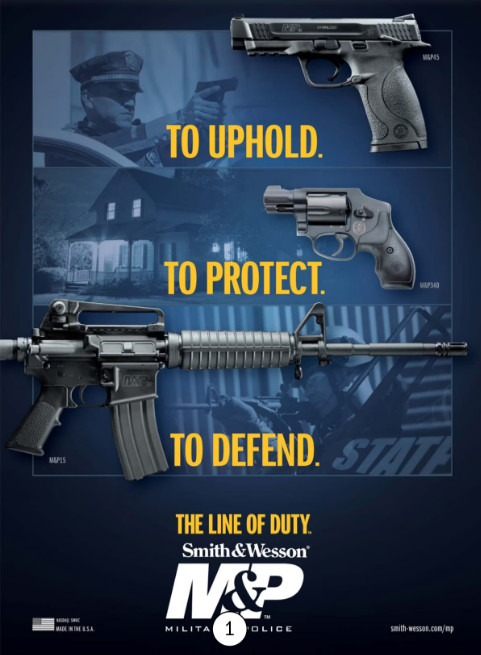
6 ... 
7 ... 
8 ... 
9 ... 
10 ... 
11a ... 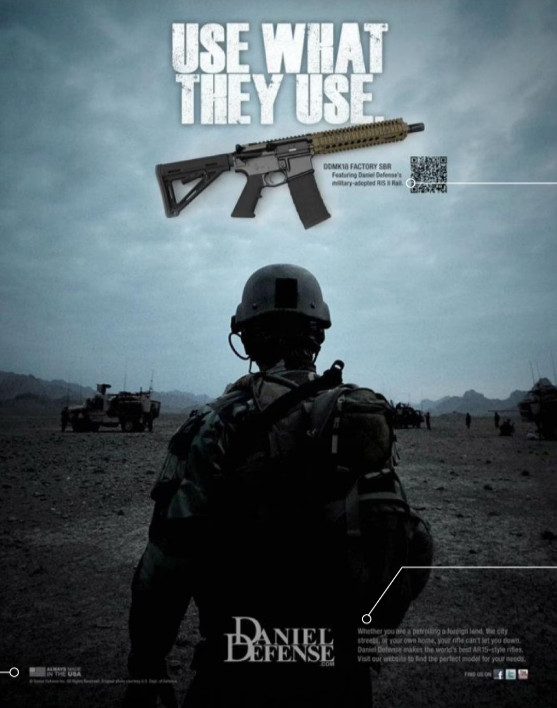
12 ... 1957 Armalite makes a prototype Gunmaker Armalite starts work on a prototype based on the U.S. military’s desire for a lightweight rifle capable of automatic fire. The company dubs it the Armalite Rifle Model 15, or AR-15. 1959 Colt acquires the AR-15 Unconvinced its gun had a military future, Armalite sells the rights for the AR-15 to Colt’s Patent Firearms Manufacturing Co. Colt would later produce the rifle for the U.S. military, which designates it the M16. 1964 AR-15 enters the civilian market Colt releases the AR-15 Sporter, a semiautomatic variant of its military rifle, for civilian buyers. .” 1985, Colt (American Rifleman magazine ) “For a rancher …” “… battle proven …” “… as accurate as it is dependable.” 1993, Colt (“1993 New Products Tri-fold” brochure) Note: This rifle is built on the AR platform but is chambered in a caliber larger than typical AR-15s. “… game-getting power …” “… shrugs off the abuses of brush and boulders …” “… hunting companion.” End of carousel 1968 Gun Control Act of 1968 Prompted by the assassinations of President John F. Kennedy in 1963 and Martin Luther King Jr. in 1968, this act mandates that only a licensed dealer can sell a rifle or shotgun to someone at least 18 and a handgun to someone at least 21. The act also required serial numbers for firearms. 1977 Expiration of Colt’s patents An active marketplace emerges for other manufacturers to produce and sell their own semiautomatic rifles built on the AR-15 platform. The term “AR-15” is derived from Armalite’s original design rather than a specific brand and has been used since as a catchall to describe the rifle style. 2010, Smith & Wesson (American Rifleman magazine) “Tested. Proven. Selected.” “… proving itself by winning department testing and evaluations across the country.” “… tactical advantage …” 2008, Stag Arms (Guns & Weapons for Law Enforcement magazine) “When your life depends on it …” “… you’re never alone.” End of carousel 1989 Executive order bans imports of some rifles President George H.W. Bush signs an executive order banning the importation of semiautomatic rifles after a gunman used a Chinese-made AK-47 variant to kill five students outside a school in Stockton, Calif. 1994 Federal assault weapons ban President Bill Clinton pushes the assault weapons ban through Congress with some bipartisan support. The Public Safety and Recreational Firearms Use Protection Act outlawed firearms with common semiautomatic rifle features, such as adjustable stocks and detachable magazines. People who already owned such guns were allowed to keep them. 2001 Sept. 11 attacks prompt U.S. wars Imagery from the wars in Afghanistan and Iraq shows troops carrying M4 rifles, the military cousin of the modern AR-15. 2004 Ban expires The assault weapons ban sunsets, allowing civilians to once again purchase such rifles, including versions of the AR-15, depending on local laws and restrictions. yle rifles,” she said. 2007 “Lone Survivor” is a bestseller The Navy SEAL memoir and subsequent film introduce shadowy commandos to audiences, helping create waves of interest in tactical weapons and gear. 2009 Launch of “Call of Duty: Modern Warfare 2” The video game, what many fans consider the high-water mark for the Call of Duty series, is released. An AR-15 is the closest a civilian can get to wielding one of the most popular guns in the game, the M4 carbine rifle. Gun industry introduces the term “modern sporting rifle” As sales of AR-15s cooled after a 2008 spike, the National Shooting Sports Foundation adopts this marketing term as a way to describe modular semiautomatic rifles like AR-15s. President Barack Obama’s inauguration Soon after Obama’s election, domestic production of semiautomatic rifles surpasses the previous year by nearly 60 percent, according to industry data, representing the first major production spike since the assault weapons ban expired. home,” the ad said, “your rifle can’t let you down.” 2012 Mass shooting in Newtown, Conn. Armed with two handguns, one shotgun and a Bushmaster XM15-E2S rifle, a gunman kills his mother in their home and then 26 people at Sandy Hook Elementary School before he fatally shoots himself. AR-15 production doubles after Sandy Hook According to industry data, production soars, suggesting consumers feared a new ban would be passed. 2014 “American Sniper” is released This film about a Navy SEAL become the highest-grossing war film ever released in the United States. 2016 “America’s Rifle” The National Rifle Association dubs the AR-15 “America’s Rifle,” part of an effort to bolster the image of a weapon coming under attack from gun-control advocates. Production surges leading up to the 2016 election Production of rifles spikes by 53 percent, according to industry data, as gun rights advocates and industry allies stoke fear of new gun-control laws if Hillary Clinton succeeded in securing the presidency. 2020 Instability fuels sales AR-15 production spikes by 51 percent, prompted by the uncertainty surrounding the coronavirus pandemic, racial justice protests and a bitter presidential campaign.
| The text being discussed is available at | https://www.washingtonpost.com/nation/interactive/2023/sutherland-springs-shooting-survivors-ar-15-scars/ and |
|
SITE COUNT< Blog Counters Reset to zero January 20, 2015 | TrueValueMetrics (TVM) is an Open Source / Open Knowledge initiative. It has been funded by family and friends. TVM is a 'big idea' that has the potential to be a game changer. The goal is for it to remain an open access initiative. |
| WE WANT TO MAINTAIN AN OPEN KNOWLEDGE MODEL | A MODEST DONATION WILL HELP MAKE THAT HAPPEN | |
|
The information on this website may only be used for socio-enviro-economic performance analysis, education and limited low profit purposes
Copyright © 2005-2021 Peter Burgess. All rights reserved. | ||